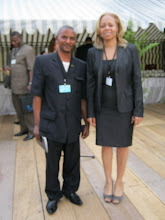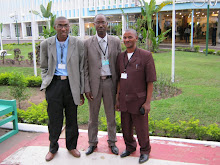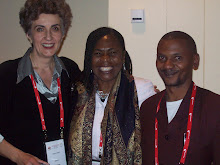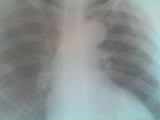jeudi 7 juillet 2011
RAPPORT DE SENSIBILISATION SUR LA PREVENTION DU CANCER DU COL UTERIN: AU CENTRE DE SANTE VIRUNGA
Rapport de formation et workshop sur la prévention du cancer du col utérin: diagnostique et traitement des lésions précancéreuses.
Contexte
Au mois de Janvier 2011, AGIR ENSEMBLE a organisé une formation et un workshop a l’intention des médecins et infirmiers de la ville de Goma avec l’appui financier de l’UICC. Ces activités ont porté sur la prévention du cancer du col utérin: Diagnostic et traitement des lésions précancéreuses. Mais jusque la, nous n’avons pas la machine de cryothérapie, ce qui constitue un obstacle pour la mise en œuvre effective du programme de screening dans nos hôpitaux.
Justification
Le cancer est devenu la grande priorité de santé publique et tue plus que le HIV, Tuberculose et malaria mis ensemble. Il a été établi qu’il y a 28 millions des personnes atteintes du cancer dans le monde avec une prévalence de 12 millions chaque année et une mortalité de 8 millions chaque année.
Le cancer du col de l’utérus vient en 2e position dans le monde en ce qui concerne la mortalité et en 1ere position dans le pays en voie de développement. Il a été démontré que le cancer du col utérin peut être prévenu à 100% avec des moyens très simples: screening, traitement et vaccin anti-HPV.
Objectifs
1. Former 8 professionnels de santé (4 médecins et 4 infirmiers) en dépistage et traitement des lésions précancéreuses.
2. Tenir un «workshop» de 2 jours pour former 28 professionnels de santé en matière de screening et traitement des lésions précancéreuses pour la sensibilisation continue des mamans lors des séances de CPN et de vaccination.
Résultats atteints
A. Formation de 2 jours: 8 professionnels de santé ont été formés avec succès sur la matière susmentionnée dont 3 médecins et 5 infirmiers:
Tous les participants ont réussi le post-test avec plus de 76% et tous ont signé le feuillet d’engagement pour la lutte continue contre le cancer comme une grande priorité de santé publique.
Indicateur1: 3 médecins formés/4 attendus= 75%
Indicateur2: 5 infirmiers formés/4 attendus=125%
En bref, l’objectif a été atteint à 100% : 75+125 divisée par 2= 100%
A l’issue de cette formation 8 professionnels de santé de la ville de Goma sont maintenant compétents à réaliser le dépistage pour le cancer du col utérin et livrer le service aux mamans pour prévenir à 100% le cancer du col de l’utérus.
Un module de formation est disponible comme livre de référence pour les professionnels de santé. Il est vrai qu’il s’agit d’une nouvelle matière pour les professionnels de santé congolais et ce document va être une bonne source d’information pour le développement des
capacités.
B. Un workshop de 2 jours s’est tenu comme prévu et 25 professionnels de santé ont participé activement à ce workshop dont 5 médecins et 20 infirmiers.
Tous les participants ont été actifs dans les travaux en groupes et tous ont signé le feuillet d’engagement pour la lutte continue contre le cancer comme une grande priorité de santé publique.
Indicateur 1: 25 participants/28 attendus= 89.3%
Indicateur 2: 25 personnes ont participé activement à l’adoption du guide/ 25 attendus = 100%.
A l’issue du workshop, un guide du sensibilisateur vient d’être adopté et mis à la disposition des institutions de santé pour usage dans la sensibilisation continue des mamans pour qu’elles demandent le service de screening aux professionnels de santé. Cela permettra la disponibilité du service de screening et le plaidoyer pour la disponibilité du service de traitement (achat de machine de cryothérapie).
Tous les participants ont reçu chacun une copie du guide.
Pour ce workshop, un rappel de quelques sujets de formation a été donné notamment sur les démarches diagnostiques des lésions précancéreuses, le traitement par cryothérapie, l’épidémiologie et l’histoire naturelle du cancer du col utérin.
Ce rappel consiste à la mise en niveau des participants du workshop qui n’ont pas suivi la formation. Ainsi donc tous les participants à ce workshop sont aussi capables de pratiquer le screening et le traitement des lésions précancéreuses.
Les facilitateurs ont donné les orientations nécessaires pour le déroulement des travaux mais en gros les travaux se sont faits en groupes. Quatre groupes ont été formés dirigés chacun par 2 cadres qui ont suivi la première formation.
Ce programme va se poursuivre avec la sensibilisation dans 3 centres de santé de la ville de Goma pour informer les mamans de l’importance du screening pour prévenir à 100% le cancer du col utérin, leur permettre de demander le service de screening et d’adhérer au programme quand il est disponible.
NB: Le grand obstacle pour la mise en œuvre effective de ce programme est le manque des moyens pour le traitement des lésions précancéreuses: la machine de cryothérapie et cela doit être une matière de plaidoyer pour chacun de nous tous pour éviter aux mamans de faire de longues distances Goma-Kampala ou Goma-Kigali pour le traitement.
Fait à Goma, le 01 Février 2011
Dr Mateus KAMBALE SAHANI
Directeur du Département de Santé
AGIR ENSEMBLE/RDC.
jeudi 9 juin 2011
Agir Ensemble comments for Civil Society Interactive Hearing for UN summit on NCDs
On behalf of AGIR ENSEMBLE, a NGO based in Goma/DRC, member of UICC and FCA, I would like to share
with you our views on the possible outcomes of the Summit and propose the following specific
recommendations to be incorporated in the final Outcomes Document that will be endorsed by UN member
states at the High-level Meeting on NCDs.
Our organisation has been extensively involved in cancers and tobacco controls.
From our own experience, we believe that civil society has been instrumental in promoting strong cancer
and tobacco control measures, overseeing their implementation, and fostering public support for
governments’ cancers and tobacco control policies.
Yet more needs to be done. More than 8 million people die each year by cancer and 6 million annually
due to global tobacco use and WHO-GLOBOCAN data base shows that cancer is the leading cause of
mortality in developing country including DRC and cervical cancer takes the first place. Cervical cancer is
100% avoidable but it continues to kills women in developing countries; so programs of screening and
vaccination against HPV must be implemented in all countries to avoid these avoidable deaths.
Tobacco use is the only risk factor common to the four major groups of NCDs. As a result, implementing the
tobacco control measures specified in the World Health Organization (WHO) Framework Convention on
Tobacco Control (FCTC) – which has more than 170 Parties representing 87% of the world’s population – is
one of the best ways to tackle NCDs. The UN Secretary-General Report on NCDs reaffirms the effectiveness
and efficiency of the key interventions in the WHO FCTC.
We would like to strongly encourage all UN member states to adopt an outcomes document that reflects
positions adopted by the civil society movement - the NCD Alliance - and specifically:
· Calls on countries that have not yet done so, to ratify the FCTC. Key tobacco control interventions
of the WHO FCTC are not only highly cost-effective but also cheap, feasible and culturally acceptable
to implement.
· Commits member states to ensure that their government cooperates actively to accelerate the
implementation of the strategies to control and treat NCDs.
· Sets a short-term global target for prevalence of NCDs and tobacco use that is both ambitious and
achievable and calls on all governments to set national/regional targets which should be revised
regularly. Monitoring trends and progress is essential to ensuring that commitments are honoured.
· Calls on all governments to integrate NCDs in all relevant national plans for health, development
and poverty reduction, and strongly encourages global investment in some key strategies to
reduce prevalence and incidence of NCDs like FCTC implementation, screening for cervical cancer,
vaccination programs for HPV and HBV including technical and financial assistance and scientific
research.
· Calls on all governments to recognise the importance of NCDs and all risk factors to the
achievement of the Millennium Development Goals (MDGs), integrate FCTC implementation,
screening for cancer, vaccination programs for HPV and HBV into development assistance
programmes and the planning processes of UN, bilateral and multilateral development agencies.
NCDs are a growing threat even in the poorest countries in the world, with socioeconomic impacts
that threaten the attainment of the MDGs. Full-scale action on NCDs and the development of global
and national targets and indicators are crucial steps to prevent the NCD epidemic from becoming a
severe health emergency.
Best regards,
Mateus Kambale Sahani, M.D.
AGIR ENSEMBLE/DRC
mardi 24 mai 2011
WHO NCDs Consultation meeting-Brazzaville



 Dear all,
We have been in Brazzaville for the consultation meeting and the voice of cancer has been head. We have insisted that HPV, HBV and vaccines to be included in the outcome document, NCDs to be included in future MDGs and our position has been taken in consideration. More information will be found in the meeting report that I have a hard copy and I’ll order an electronic copy that I’ll send to you (It is a big copy of 32 pages).
Specifically for Africa, other main health issues have been added in the declaration: mental health, violence and injuries.
I think that at this stage, we have gained a sufficient success but many things remain to be done. As all NCDs are together in the same program, I have fear that the program of cancer has to be forgotten in the national level as many policy makers and stakeholders don’t know more about cancer.
The next step will be Moscow meeting for all ministers of the world. I would like you to be present at this meeting to make sure that something important didn’t be omitted from the document and finally in New York for the summit.
UICC is a big institution with more than 300 member organizations in more than 100 countries; I think that at this stage missing UICC representative offices (Africa, Asia, Europe, Latine America, etc.) is a weakness for the UICC as a union.
I get accommodation at Royal Hotel which doesn’t have a restaurant and I could find my breakfast and diner outside the hotel, arrival on April 3, 2011 at 12H20 and departure April 7, 2011 at 10H30.
I have sent you also, in attachment, the reimbursement form and I would like you to take 500$ US for AGIR ENSEMBLE membership dues payment for 2011 year and send the difference.
I have sent you also some photos of the event, other photos will be sent after.
Thank you and best regards,
Dr Mateus Kambale Sahani
Agir Ensemble/DRC.
Dear all,
We have been in Brazzaville for the consultation meeting and the voice of cancer has been head. We have insisted that HPV, HBV and vaccines to be included in the outcome document, NCDs to be included in future MDGs and our position has been taken in consideration. More information will be found in the meeting report that I have a hard copy and I’ll order an electronic copy that I’ll send to you (It is a big copy of 32 pages).
Specifically for Africa, other main health issues have been added in the declaration: mental health, violence and injuries.
I think that at this stage, we have gained a sufficient success but many things remain to be done. As all NCDs are together in the same program, I have fear that the program of cancer has to be forgotten in the national level as many policy makers and stakeholders don’t know more about cancer.
The next step will be Moscow meeting for all ministers of the world. I would like you to be present at this meeting to make sure that something important didn’t be omitted from the document and finally in New York for the summit.
UICC is a big institution with more than 300 member organizations in more than 100 countries; I think that at this stage missing UICC representative offices (Africa, Asia, Europe, Latine America, etc.) is a weakness for the UICC as a union.
I get accommodation at Royal Hotel which doesn’t have a restaurant and I could find my breakfast and diner outside the hotel, arrival on April 3, 2011 at 12H20 and departure April 7, 2011 at 10H30.
I have sent you also, in attachment, the reimbursement form and I would like you to take 500$ US for AGIR ENSEMBLE membership dues payment for 2011 year and send the difference.
I have sent you also some photos of the event, other photos will be sent after.
Thank you and best regards,
Dr Mateus Kambale Sahani
Agir Ensemble/DRC.
mardi 14 décembre 2010
Agir Ensemble will be implenting new program for cervical cancer prevention
AGIR ENSEMBLE, in its efforts to prevent cancer, will be implementing a new program for cervical cancer prevention. It is a campaign for cervical cancer prevention during 6 months from January 2011 which includes a training of doctors and nurses in cervical cancer screening. This program is financially supported by UICC Cancer Campaign.
Thank you.
Dr Sahani.
Capacity Building Workshop Training of UICC in Cape Town
Capacity of health professionals in cervical cancer screening in Goma/DRC M. Kambale Sahani1,2, M.M. Mutumwa3, P.K. Mukama4


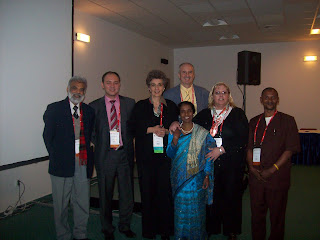
 Capacity of health professionals in cervical cancer screening in Goma/DRC
M. Kambale Sahani1,2, M.M. Mutumwa3, P.K. Mukama4
1Health Department, AGIR ENSEMBLE, 2Virunga General Hospital-GOMA, 3Clinic Chaine de l'Espoire-GOMA, 4Centre Medical Belle vue, GOMA, The Democratic Republic of the Congo
Overview
Cancer is now the leading cause of death worldwide, 28 million of people live with cancer in the world and 8 million die each year by the disease. In DRC, cancer killed approximately 33,000 people in 2005 and cervical cancer was the killer no 1 among women and prostate cancer among men. If nothing is done now, this figure will reach 65,000 in 2030. Source: WHO infobase
In DRC no woman has access to cervical cancer screening in all the life (service not available in all the country, a country of more than 70,000,000 people).
Objectives
This research project aims to know the degree of understanding and competency of health professionals (doctors and nurses) in screening methods (VIA and VILI) to make sure that the screening can be initiated without any difficulty in the city of Goma and, if there are difficulties, how they can be solved to this services being accessible to people. To measure also their capacity of using cryotherapy for treatment of precancerous lesions.
Method
We used the STEPS Method of the WHO, especially Step 1 using questionnaire and interview of 50 doctors (general practitioners) and 500 nurses in the city of Goma. Sample was constituted from all public and private hospitals and health centers of the city. We used comparative statistic test among people who know the method and those who don’t know it.
Hypothesis
Our study was focused on the following hypothesis:
- Health professionals know well the usage of VIA and VILI methods,
- Health professionals usually educate their patients on prevention of cervical cancer,
- Health professionals know how to use cryotherapy to treat precancerous lesions.
Results
At the end of our study, we found that:
1. 85% of doctors (43) never understand about VIA and VILI methods and 98% of nurses (490) are too.
2. 10% of doctors (5) have understood about the methods but don’t know how to proceed and 1% of nurses (5) are too.
3. 5% of doctors (3) know the substances used for VIA and for VILI but don’t know how they are used and 1% of nurses (5) are too.
4. 10% of doctors (5) give an education message to their patients (avoid genital infections) and 2% of nurses (10) do too.
5. 10% of doctors (5) are aware of HVP vaccine to prevent cervical cancer and no nurses (0) know that.
6. No health professional (doctors or nurses) knows that precancerous lesions can be treated and no one knows how to use cryotherapy.
7. No health professional (doctors or nurses) has participated in a campaign for cervical cancer prevention.
8. No health institution in Goma has a screening service.
Conclusions
Health professionals in the city of Goma don’t have sufficient skills in cervical cancer screening and HPV vaccine. This constitutes a need for training in this area and it is also a big challenge to the availability of the service.
Capacity of health professionals in cervical cancer screening in Goma/DRC
M. Kambale Sahani1,2, M.M. Mutumwa3, P.K. Mukama4
1Health Department, AGIR ENSEMBLE, 2Virunga General Hospital-GOMA, 3Clinic Chaine de l'Espoire-GOMA, 4Centre Medical Belle vue, GOMA, The Democratic Republic of the Congo
Overview
Cancer is now the leading cause of death worldwide, 28 million of people live with cancer in the world and 8 million die each year by the disease. In DRC, cancer killed approximately 33,000 people in 2005 and cervical cancer was the killer no 1 among women and prostate cancer among men. If nothing is done now, this figure will reach 65,000 in 2030. Source: WHO infobase
In DRC no woman has access to cervical cancer screening in all the life (service not available in all the country, a country of more than 70,000,000 people).
Objectives
This research project aims to know the degree of understanding and competency of health professionals (doctors and nurses) in screening methods (VIA and VILI) to make sure that the screening can be initiated without any difficulty in the city of Goma and, if there are difficulties, how they can be solved to this services being accessible to people. To measure also their capacity of using cryotherapy for treatment of precancerous lesions.
Method
We used the STEPS Method of the WHO, especially Step 1 using questionnaire and interview of 50 doctors (general practitioners) and 500 nurses in the city of Goma. Sample was constituted from all public and private hospitals and health centers of the city. We used comparative statistic test among people who know the method and those who don’t know it.
Hypothesis
Our study was focused on the following hypothesis:
- Health professionals know well the usage of VIA and VILI methods,
- Health professionals usually educate their patients on prevention of cervical cancer,
- Health professionals know how to use cryotherapy to treat precancerous lesions.
Results
At the end of our study, we found that:
1. 85% of doctors (43) never understand about VIA and VILI methods and 98% of nurses (490) are too.
2. 10% of doctors (5) have understood about the methods but don’t know how to proceed and 1% of nurses (5) are too.
3. 5% of doctors (3) know the substances used for VIA and for VILI but don’t know how they are used and 1% of nurses (5) are too.
4. 10% of doctors (5) give an education message to their patients (avoid genital infections) and 2% of nurses (10) do too.
5. 10% of doctors (5) are aware of HVP vaccine to prevent cervical cancer and no nurses (0) know that.
6. No health professional (doctors or nurses) knows that precancerous lesions can be treated and no one knows how to use cryotherapy.
7. No health professional (doctors or nurses) has participated in a campaign for cervical cancer prevention.
8. No health institution in Goma has a screening service.
Conclusions
Health professionals in the city of Goma don’t have sufficient skills in cervical cancer screening and HPV vaccine. This constitutes a need for training in this area and it is also a big challenge to the availability of the service.
jeudi 27 mai 2010
Raising Awareness Session in Goma/DRC
 1. Introduction
On April 24th, 2010, AGIR ENSEMBLE has organized a Raising Awareness Session (RAS) on tobacco control for youth in the church community (CBCA KESHERO) in the city of Goma. We had planned to join together 50 young people of the community church and inform them that tobacco is dangerous for their health and explain them the strategies used by the industry to grow its clients.
This session took place normally as expected and got the audience of 59 young people joining the meeting.
The duration of the event was 2 hours from 2:00 pm to 4:00 pm.
2. Objective of the session
AGIR ENSEMBLE, in its commitment of spreading information which can save lives and maintain the health of population in the community, settled following objectives for this session:
- Bring together a group of 50 young people from KESHERO CBCA community church, who can receive the message that tobacco is a global priority of public health,
- To teach to the group how to protect himself and to protect others against tobacco smoking, the reason of not begin smoking and at the end of the session at least 95 % of participants will know correctly the importance of not to begin smoking.
3. Context of organization
Considering the financial difficulty, the event was held in the worship hall of KESHERO CBCA CHURCH from 2:00 pm till 4:00 pm. The event has been attended by 59 persons among whom 38 females and 21 males. We didn’t find possibility to make T-SHIRTS for participants.
4. Progress of the event
The event took place around the subject:
"Tobacco and youth", the role of youth in tackling tobacco usage.
The moderator of the session was Mr. Alphonse KAVWIRWA, president of the Board of AGIR ENSEMBLE and the speaker was Dr Mateus KAMBALE SAHANI, the director of the Health Department of AGIR ENSEMBLE.
The session began with the allocution of the president of AGIR ENSEMBLE, Mr. Alphonse KAVWIRWA who welcomed all participants to the session of the day and presented the missions of AGIR ENSEMBLE.
Then Dr Mateus SAHANI began explaining the background of the event and presented the relevance of acting against tobacco. “Most importantly, our collective voice must show our commitment to fight tobacco in our community and worldwide and it must be a global priority for the public health” he said.
After this, the speaker began the session “Tobacco and Youth, the role of young people in the fight against tobacco” in which he gave the place held by tobacco as a big public health threat. “Tobacco is the first Risk factor of cancer and kills each year 5.4 million people worldwide and cancer is becoming the leading cause of death worldwide. We know that cancer kills 8 million people each year and if nothing is done by now cancer will kill 12 million of people. Every one may act by now if you want to save the 28 million of people living with cancer in the world and if you want to address the cancer burden worldwide. The voice of each one is needed for the fight”, he said.
Then some questions were asked and answered by the speaker. All participants were interested by the session of the day and 15 questions have been received. Almost all questions were well answered. After this a cocktail was offered to participants.
5. Participants
In total 59 people attended the meeting among whom 38 females and 21 males and were interested by the theme of the day.
6. Evaluation of the session.
We expected 50 people for the meeting and brought together 59. This objective was reached in 118%. The second objective was reached in 90%. In all our performance was 104%. The main barriers for us to reach our maximum of goals were the background of the organization of the event, and missing financial support and we didn’t be able to organize transport for participants.
7. Questions and recommendations
Some pertinent Questions
- What is the importance of tobacco for community and for smokers?
- If tobacco kills 5.4 million of people each year, why is it allowed to be selled?
- Are governments aware that tobacco kills people and cause diseases? What are they doing to protect people?
- What can be our attitude as young people towards our parents who smoke?
- What is the good strategy we can use to sensitizer our parents who smoke?
- What can be the attitude of a wife towards her husband who is smoking?
- Why industry targets young for its activities?
Recommendations
At the end of the event, participants have recommended:
- To organize multiple sessions like this one to allow spreading the message that can save lives of population.
- To choose a place and a moment which allow more people to attend the event for the next time.
- Such events need financial support for a real success: media campaigns, advocacy with politicians, etc. Can LAF help us?
8. Conclusions
Generally the activities of the planned were well realized and it was a real success even if there were some difficulties. All was done as planed and our objectives were reached. Participants were satisfied by the event and the message was new for almost 97% of them. They recommend us to them more information and strategies to allow them to sensitizer their parents who are smoking and they ask us to give them some posters to be used in their living rooms.
Goma, April 24th, 2010.
Dr Mateus KAMBALE SAHANI
AGIR ENSEMBLE/DRC
1. Introduction
On April 24th, 2010, AGIR ENSEMBLE has organized a Raising Awareness Session (RAS) on tobacco control for youth in the church community (CBCA KESHERO) in the city of Goma. We had planned to join together 50 young people of the community church and inform them that tobacco is dangerous for their health and explain them the strategies used by the industry to grow its clients.
This session took place normally as expected and got the audience of 59 young people joining the meeting.
The duration of the event was 2 hours from 2:00 pm to 4:00 pm.
2. Objective of the session
AGIR ENSEMBLE, in its commitment of spreading information which can save lives and maintain the health of population in the community, settled following objectives for this session:
- Bring together a group of 50 young people from KESHERO CBCA community church, who can receive the message that tobacco is a global priority of public health,
- To teach to the group how to protect himself and to protect others against tobacco smoking, the reason of not begin smoking and at the end of the session at least 95 % of participants will know correctly the importance of not to begin smoking.
3. Context of organization
Considering the financial difficulty, the event was held in the worship hall of KESHERO CBCA CHURCH from 2:00 pm till 4:00 pm. The event has been attended by 59 persons among whom 38 females and 21 males. We didn’t find possibility to make T-SHIRTS for participants.
4. Progress of the event
The event took place around the subject:
"Tobacco and youth", the role of youth in tackling tobacco usage.
The moderator of the session was Mr. Alphonse KAVWIRWA, president of the Board of AGIR ENSEMBLE and the speaker was Dr Mateus KAMBALE SAHANI, the director of the Health Department of AGIR ENSEMBLE.
The session began with the allocution of the president of AGIR ENSEMBLE, Mr. Alphonse KAVWIRWA who welcomed all participants to the session of the day and presented the missions of AGIR ENSEMBLE.
Then Dr Mateus SAHANI began explaining the background of the event and presented the relevance of acting against tobacco. “Most importantly, our collective voice must show our commitment to fight tobacco in our community and worldwide and it must be a global priority for the public health” he said.
After this, the speaker began the session “Tobacco and Youth, the role of young people in the fight against tobacco” in which he gave the place held by tobacco as a big public health threat. “Tobacco is the first Risk factor of cancer and kills each year 5.4 million people worldwide and cancer is becoming the leading cause of death worldwide. We know that cancer kills 8 million people each year and if nothing is done by now cancer will kill 12 million of people. Every one may act by now if you want to save the 28 million of people living with cancer in the world and if you want to address the cancer burden worldwide. The voice of each one is needed for the fight”, he said.
Then some questions were asked and answered by the speaker. All participants were interested by the session of the day and 15 questions have been received. Almost all questions were well answered. After this a cocktail was offered to participants.
5. Participants
In total 59 people attended the meeting among whom 38 females and 21 males and were interested by the theme of the day.
6. Evaluation of the session.
We expected 50 people for the meeting and brought together 59. This objective was reached in 118%. The second objective was reached in 90%. In all our performance was 104%. The main barriers for us to reach our maximum of goals were the background of the organization of the event, and missing financial support and we didn’t be able to organize transport for participants.
7. Questions and recommendations
Some pertinent Questions
- What is the importance of tobacco for community and for smokers?
- If tobacco kills 5.4 million of people each year, why is it allowed to be selled?
- Are governments aware that tobacco kills people and cause diseases? What are they doing to protect people?
- What can be our attitude as young people towards our parents who smoke?
- What is the good strategy we can use to sensitizer our parents who smoke?
- What can be the attitude of a wife towards her husband who is smoking?
- Why industry targets young for its activities?
Recommendations
At the end of the event, participants have recommended:
- To organize multiple sessions like this one to allow spreading the message that can save lives of population.
- To choose a place and a moment which allow more people to attend the event for the next time.
- Such events need financial support for a real success: media campaigns, advocacy with politicians, etc. Can LAF help us?
8. Conclusions
Generally the activities of the planned were well realized and it was a real success even if there were some difficulties. All was done as planed and our objectives were reached. Participants were satisfied by the event and the message was new for almost 97% of them. They recommend us to them more information and strategies to allow them to sensitizer their parents who are smoking and they ask us to give them some posters to be used in their living rooms.
Goma, April 24th, 2010.
Dr Mateus KAMBALE SAHANI
AGIR ENSEMBLE/DRC
Inscription à :
Articles (Atom)











